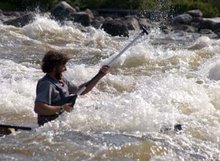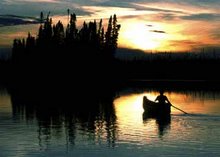

2007 Rupert River Film Expedition Summary
• The Rupert River is a major river in Northern Quebec. It is one of the last untouched rivers of its size on the continent, and contains 65 major rapids. It flows through pristine wilderness for 380 miles.
• The Rupert is scheduled to be diverted by 4 large dams, 70 pour-over dams or weirs, a giant spillway which will reverse the rivers flow, 75 dikes, 3 kilometers of tunnel, and 12 kilometers of canals. The diversion will create 400 square miles of standing water and reduce the flow of the Rupert by over 70%. Roads, power lines, temporary cities, and two new power stations will be built in the wilderness.
• 81% of the indigenous Cree affected by the diversion voted not in favor of the project in December 2006. Quebec authorities are permitting construction to begin despite this fact.
• Our cast/crew includes professional kayakers and experts in the fields of marine biology and hydrology. We will run the Rupert in July/August 2007. Our purpose is to document the majesty of the river and aid the Crees in preserving their way of life. The expedition will draw much needed attention to this issue. The film will spread the news even further and make a call to action to save the Rupert River.
• We are raising money for the expedition and film to reach their potential.
Proposal
Eric Cheezo is a 44-year old Cree who was born along the banks of the Rupert. Like his father and grandfathers before him, he makes his living by hunting, trapping, and guiding on the river. Soon, he may have to abandon his home, livelihood, and the graves of his ancestors in order to find a new way to feed his family.
Proponents of the project promise the diversion will create jobs, boost the regions economy, and provide more power to sell to the United States. The jobs and economic boost will be temporary. The permanent loss of the Rupert will destroy many lives and remove forever one of the great remaining natural wonders of the continent. If the project succeeds, the mercury in the soil will leach into the river where the water is made stagnant by the dams. What little remains of the Rupert will be a poisoned trickle in a granite bed where a natural wonder now roars. Hydro-Quebec, the company proposing the project, has done little to explore alternative forms of power such as wind power in the forty years that they have been promoting this project.
The Rupert harbors extensive fisheries and serves as a major wilderness corridor for 300 species of migratory birds and 44 species of mammals. Cree still depend on the Rupert in the same way they have for five thousand years. The water is in a pristine state, and can be drunk without filtering. For whitewater enthusiasts, the Rupert is an ideal playground, offering multiple month-long wilderness trip itineraries that are unrivaled anywhere in scenery and challenge. Among the many rapids, six have never been run. The average annual flow exceeds 100,000 cubic feet per second.
This issue is caused directly by North Americans, and will directly affect North Americans. We also have the exclusive power to stop it. By reducing our personal consumption, investing in alternative sources of energy, and supporting causes such as the fight to save the Rupert, we can stop adding chapters to the story of a dominant culture invading this continent and erasing the way of life of its native inhabitants.
A look at the Film
Flashes of a kayaker emerge from within a thundering mass of whitewater. Somehow she makes it through the rapids into a safe eddy the size of a football field. The frame pulls back, zooming out until the paddler is a tiny dot disappearing on the horizon of the giant river. Cut away to a Quebec courtroom in Montreal. A Cree elder explains to a judge how the destruction of the Rupert will end the way of life his people have been practicing for five thousand years.
Parallel editing will be used to tell the story of the Rupert while documenting its rapids in riveting whitewater scenes. The combined themes will build toward catharsis and denouement, after which animations and dialogue will inform viewers as to what they can do to lessen their power consumption and help save the Rupert from destruction.
We will use cinema verite techniques, filming real life as it happens with people interacting rather than being directly interviewed. The kayaking and canoeing will be filmed in the exciting idiom of modern paddling films, informative sections will use a documentary style combined with animations to present the story in an inviting, entertaining, and dynamic way.
Post-Production and Marketing
This film will move beyond the paddling film format, as well as beyond the stereotype of the dour documentary. Our intention is to give the film legs that will transcend the usual markets for these genres as well. The diversity of the film will appeal to a wide range of veiwers.
Post-production will be handled at the studios of Interloper Films, a well-established documentary film production company in Los Angeles. We plan to use a producers representative such as Ostrow and Company, also in L.A., to distribute the film, track sales, ensure it is seen by as many as possible, and maximize revenue potential.
Our film will play a pivotal role in the movement being lead by the new Grand Chief of the Cree Nation, Matthew Mukash, who is offering to develop wind power on Cree land rather than sacrifice the Rupert.
Check out some pix of the Rupert by rezmutt
Explore ways to lower your personal consumption at home at this site!

